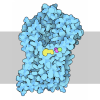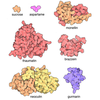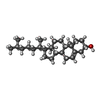[English] 日本語
 Yorodumi
Yorodumi- PDB-7xbx: Cryo-EM structure of the human chemokine receptor CX3CR1 in compl... -
+ Open data
Open data
- Basic information
Basic information
| Entry | Database: PDB / ID: 7xbx | ||||||||||||
|---|---|---|---|---|---|---|---|---|---|---|---|---|---|
| Title | Cryo-EM structure of the human chemokine receptor CX3CR1 in complex with CX3CL1 and Gi1 | ||||||||||||
 Components Components |
| ||||||||||||
 Keywords Keywords | SIGNALING PROTEIN / G protein-coupled receptor / chemokine receptor / CX3CR1 / CX3CL1 | ||||||||||||
| Function / homology |  Function and homology information Function and homology informationC-X3-C chemokine receptor activity / dendritic tree / multiple spine synapse organization, single dendrite / negative regulation of microglial cell mediated cytotoxicity / macropinosome membrane / C-X3-C chemokine binding / regulation of microglial cell migration / CXCR1 chemokine receptor binding / positive regulation of calcium-independent cell-cell adhesion / negative regulation of interleukin-1 alpha production ...C-X3-C chemokine receptor activity / dendritic tree / multiple spine synapse organization, single dendrite / negative regulation of microglial cell mediated cytotoxicity / macropinosome membrane / C-X3-C chemokine binding / regulation of microglial cell migration / CXCR1 chemokine receptor binding / positive regulation of calcium-independent cell-cell adhesion / negative regulation of interleukin-1 alpha production / leukocyte adhesive activation / CX3C chemokine receptor binding / negative regulation of glutamate receptor signaling pathway / microglial cell activation involved in immune response / autocrine signaling / host-mediated modulation of intestinal microbiota composition / lymphocyte chemotaxis / synapse pruning / positive regulation of microglial cell migration / regulation of lipopolysaccharide-mediated signaling pathway / central nervous system maturation / negative regulation of microglial cell activation / synapse maturation / negative regulation of neuron migration / negative regulation of hippocampal neuron apoptotic process / antifungal innate immune response / positive regulation of transforming growth factor beta1 production / chemokine receptor activity / CCR chemokine receptor binding / microglial cell proliferation / positive regulation of actin filament bundle assembly / leukocyte migration involved in inflammatory response / integrin activation / leukocyte tethering or rolling / regulation of tumor necrosis factor production / C-C chemokine receptor activity / chemokine-mediated signaling pathway / eosinophil chemotaxis / C-C chemokine binding / positive regulation of monocyte chemotaxis / leukocyte chemotaxis / G protein-coupled peptide receptor activity / regulation of nitric oxide biosynthetic process / angiogenesis involved in wound healing / chemokine activity / positive regulation of neurogenesis / Chemokine receptors bind chemokines / negative regulation of interleukin-1 beta production / positive regulation of cell-matrix adhesion / neuronal cell body membrane / neuron remodeling / positive regulation of neuroblast proliferation / positive chemotaxis / chemoattractant activity / RSV-host interactions / macrophage chemotaxis / negative regulation of interleukin-6 production / Respiratory syncytial virus (RSV) attachment and entry / negative regulation of apoptotic signaling pathway / negative regulation of tumor necrosis factor production / social behavior / negative regulation of cell-substrate adhesion / regulation of neurogenesis / negative regulation of extrinsic apoptotic signaling pathway in absence of ligand / cellular defense response / adenylate cyclase inhibitor activity / positive regulation of protein localization to cell cortex / T cell migration / Adenylate cyclase inhibitory pathway / D2 dopamine receptor binding / response to prostaglandin E / adenylate cyclase regulator activity / G protein-coupled serotonin receptor binding / neutrophil chemotaxis / adenylate cyclase-inhibiting serotonin receptor signaling pathway / extrinsic apoptotic signaling pathway in absence of ligand / positive regulation of smooth muscle cell proliferation / cellular response to forskolin / regulation of mitotic spindle organization / negative regulation of cell migration / negative regulation of angiogenesis / positive regulation of release of sequestered calcium ion into cytosol / response to ischemia / cell chemotaxis / cell projection / Regulation of insulin secretion / calcium-mediated signaling / positive regulation of cholesterol biosynthetic process / microglial cell activation / negative regulation of insulin secretion / defense response / cell-cell adhesion / G protein-coupled receptor binding / positive regulation of neuron projection development / G protein-coupled receptor activity / response to peptide hormone / adenylate cyclase-inhibiting G protein-coupled receptor signaling pathway / neuron cellular homeostasis / brain development / modulation of chemical synaptic transmission Similarity search - Function | ||||||||||||
| Biological species |  Homo sapiens (human) Homo sapiens (human) | ||||||||||||
| Method | ELECTRON MICROSCOPY / single particle reconstruction / cryo EM / Resolution: 3.4 Å | ||||||||||||
 Authors Authors | Lu, M. / Zhao, W. / Han, S. / Zhu, Y. / Wu, B. / Zhao, Q. | ||||||||||||
| Funding support |  China, 3items China, 3items
| ||||||||||||
 Citation Citation |  Journal: Sci Adv / Year: 2022 Journal: Sci Adv / Year: 2022Title: Activation of the human chemokine receptor CX3CR1 regulated by cholesterol. Authors: Minmin Lu / Wenli Zhao / Shuo Han / Xiaowen Lin / Tingyu Xu / Qiuxiang Tan / Mu Wang / Cuiying Yi / Xiaojing Chu / Weibo Yang / Ya Zhu / Beili Wu / Qiang Zhao /  Abstract: As the only member of the CX3C chemokine receptor subfamily, CX3CR1 binds to its sole endogenous ligand CX3CL1, which shows notable potential as a therapeutic target in atherosclerosis, cancer, and ...As the only member of the CX3C chemokine receptor subfamily, CX3CR1 binds to its sole endogenous ligand CX3CL1, which shows notable potential as a therapeutic target in atherosclerosis, cancer, and neuropathy. However, the drug development of CX3CR1 is hampered partially by the lack of structural information. Here, we present two cryo-electron microscopy structures of CX3CR1-G complexes in ligand-free and CX3CL1-bound states at 2.8- and 3.4-Å resolution, respectively. Together with functional data, the structures reveal the key factors that govern the recognition of CX3CL1 by both CX3CR1 and US28. A much smaller conformational change of helix VI upon activation than previously solved class A GPCR-G complex structures is observed in CX3CR1, which may correlate with three cholesterol molecules that play essential roles in conformation stabilization and signaling transduction. Thus, our data deepen the understanding of cholesterol modulation in GPCR (G protein-coupled receptor) signaling and provide insights into the diversity of G protein coupling. | ||||||||||||
| History |
|
- Structure visualization
Structure visualization
| Structure viewer | Molecule:  Molmil Molmil Jmol/JSmol Jmol/JSmol |
|---|
- Downloads & links
Downloads & links
- Download
Download
| PDBx/mmCIF format |  7xbx.cif.gz 7xbx.cif.gz | 296.4 KB | Display |  PDBx/mmCIF format PDBx/mmCIF format |
|---|---|---|---|---|
| PDB format |  pdb7xbx.ent.gz pdb7xbx.ent.gz | 227.2 KB | Display |  PDB format PDB format |
| PDBx/mmJSON format |  7xbx.json.gz 7xbx.json.gz | Tree view |  PDBx/mmJSON format PDBx/mmJSON format | |
| Others |  Other downloads Other downloads |
-Validation report
| Arichive directory |  https://data.pdbj.org/pub/pdb/validation_reports/xb/7xbx https://data.pdbj.org/pub/pdb/validation_reports/xb/7xbx ftp://data.pdbj.org/pub/pdb/validation_reports/xb/7xbx ftp://data.pdbj.org/pub/pdb/validation_reports/xb/7xbx | HTTPS FTP |
|---|
-Related structure data
| Related structure data |  33108MC  7xbwC M: map data used to model this data C: citing same article ( |
|---|---|
| Similar structure data | Similarity search - Function & homology  F&H Search F&H Search |
- Links
Links
- Assembly
Assembly
| Deposited unit | 
|
|---|---|
| 1 |
|
- Components
Components
| #1: Protein | Mass: 40447.141 Da / Num. of mol.: 1 / Mutation: S47C,G202T,G203A,E245A,A326S Source method: isolated from a genetically manipulated source Source: (gene. exp.)  Homo sapiens (human) / Gene: GNAI1 / Production host: Homo sapiens (human) / Gene: GNAI1 / Production host:  | ||||
|---|---|---|---|---|---|
| #2: Protein | Mass: 38245.805 Da / Num. of mol.: 1 Source method: isolated from a genetically manipulated source Source: (gene. exp.)  Homo sapiens (human) / Gene: GNB1 / Production host: Homo sapiens (human) / Gene: GNB1 / Production host:  | ||||
| #3: Protein | Mass: 7861.143 Da / Num. of mol.: 1 Source method: isolated from a genetically manipulated source Source: (gene. exp.)  Homo sapiens (human) / Gene: GNG2 / Production host: Homo sapiens (human) / Gene: GNG2 / Production host:  | ||||
| #4: Protein | Mass: 51558.250 Da / Num. of mol.: 1 / Mutation: G35C,I222L,L278C,C323S,M352V Source method: isolated from a genetically manipulated source Source: (gene. exp.)  Homo sapiens (human) / Gene: CX3CR1, CMKBRL1, GPR13 / Production host: Homo sapiens (human) / Gene: CX3CR1, CMKBRL1, GPR13 / Production host:  | ||||
| #5: Chemical | | Has ligand of interest | N | Has protein modification | Y | |
-Experimental details
-Experiment
| Experiment | Method: ELECTRON MICROSCOPY |
|---|---|
| EM experiment | Aggregation state: PARTICLE / 3D reconstruction method: single particle reconstruction |
- Sample preparation
Sample preparation
| Component | Name: Chemokine receptor CX3CR1 in complex with CX3CL1 Gi1 / Type: COMPLEX / Entity ID: #1-#4 / Source: RECOMBINANT |
|---|---|
| Source (natural) | Organism:  Homo sapiens (human) Homo sapiens (human) |
| Source (recombinant) | Organism:  |
| Buffer solution | pH: 7.5 |
| Specimen | Embedding applied: NO / Shadowing applied: NO / Staining applied: NO / Vitrification applied: YES |
| Vitrification | Cryogen name: ETHANE |
- Electron microscopy imaging
Electron microscopy imaging
| Experimental equipment |  Model: Titan Krios / Image courtesy: FEI Company |
|---|---|
| Microscopy | Model: FEI TITAN KRIOS |
| Electron gun | Electron source:  FIELD EMISSION GUN / Accelerating voltage: 300 kV / Illumination mode: SPOT SCAN FIELD EMISSION GUN / Accelerating voltage: 300 kV / Illumination mode: SPOT SCAN |
| Electron lens | Mode: BRIGHT FIELD / Nominal defocus max: 1500 nm / Nominal defocus min: 800 nm |
| Image recording | Electron dose: 2.1875 e/Å2 / Film or detector model: GATAN K3 BIOQUANTUM (6k x 4k) |
- Processing
Processing
| Software |
| ||||||||||||||||||||||||
|---|---|---|---|---|---|---|---|---|---|---|---|---|---|---|---|---|---|---|---|---|---|---|---|---|---|
| CTF correction | Type: NONE | ||||||||||||||||||||||||
| 3D reconstruction | Resolution: 3.4 Å / Resolution method: FSC 0.143 CUT-OFF / Num. of particles: 490779 / Symmetry type: POINT | ||||||||||||||||||||||||
| Refinement | Cross valid method: NONE Stereochemistry target values: GeoStd + Monomer Library + CDL v1.2 | ||||||||||||||||||||||||
| Displacement parameters | Biso mean: 92.34 Å2 | ||||||||||||||||||||||||
| Refine LS restraints |
|
 Movie
Movie Controller
Controller



 PDBj
PDBj
































